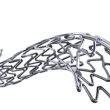In recent years, there has been an increase in the number of percutaneous coronary interventions (PCI) performed to treat chronic total occlusion (CTO). This increase is due to the availability of more advanced technology and greater experience of both operators and specialized centers. However, it is important to note that this technique is not free<a href="https://solaci.org/en/2023/06/14/frequency-and-causes-of-mortality-in-chronic-total-occlusion/" title="Read more" >...</a>
Diffuse Coronary Artery Disease: One-Year 48mm XIENCE Skypoint Outcomes
Long 48mm Stent XIENCE Skypoint in the treatment of diffuse CAD Long coronary artery lesions often involve complex decision making since they can be treated either with a long stent or with shorter overlapping stents. Both in registries and meta-analysis, the overlapping technique has been associated to increased target vessel revascularization and increased radioscopy time,<a href="https://solaci.org/en/2023/06/08/diffuse-coronary-artery-disease-one-year-48mm-xience-skypoint-outcomes/" title="Read more" >...</a>
EuroPCR 2023 | Provisional Stenting is Still the First Choice
The EBC TWO in Non-LM study randomized 200 patients with bifurcation lesions not affecting the left main coronary artery (LCA) to receive provisional stenting vs. culotte (Norobi stent). The secondary branch had to have a diameter ≥2.5 mm and a lesion length >5 mm. The crossover of those who received provisional stenting to the two-stent strategy was 16%.<a href="https://solaci.org/en/2023/05/21/europcr-2023-provisional-stenting-is-still-the-first-choice/" title="Read more" >...</a>
PICCOLETO-II: Drug-Coated Balloons in Small Vessels
Use of drug-coated balloons vs. drug-eluting stents in small caliber vessels. The constant advancements in coronary device technology have significantly reduced complication rates (such as that of restenosis). However, there are gaps where a high number of undesirable events prevail, such as small vessel disease (SVD), for which, in previous studies up, the rate of<a href="https://solaci.org/en/2023/04/28/piccoleto-ii-drug-coated-balloons-in-small-vessels/" title="Read more" >...</a>
Drug-Eluting Balloon in STEACS: Leaving No Trace is Beneficial?
Using drug-eluting balloons in patients with ST-segment elevation acute coronary syndrome. The benefits of early reperfusion in ST-segment elevation acute coronary syndromes (STEACS) have not been discussed; compared with fibrinolysis, primary percutaneous coronary intervention (pPCI) has shown benefits in terms of mortality. Despite the constant advancements in stent technology and design, these devices are not<a href="https://solaci.org/en/2023/04/18/drug-eluting-balloon-in-steacs-leaving-no-trace-is-beneficial/" title="Read more" >...</a>
Clinical Impact of Coronary Artery Disease on Results After TAVR
Coronary artery disease (CAD) coexists with aortic stenosis in about half the patients who suffer the latter. These patients receiving antiplatelet therapy are at a higher risk of periprocedural bleeding—one of the most frequent complications in patients who undergo transcatheter aortic valve replacement (TAVR). One way of limiting the risk for bleeding is choosing the<a href="https://solaci.org/en/2023/04/17/clinical-impact-of-coronary-artery-disease-on-results-after-tavr/" title="Read more" >...</a>
CTO: Length’s Impact on Success
The rise of chronic total occlusions (CTO) percutaneous coronary interventions (PCI) goes hand in hand with technological development, through still posing a great challenge, one not exactly exempt from complications. An important criterion to successful CTO PCI is length: ≥20 mm lesions lower the odds, according to J-CTO Score. However, increasing operator experience and the<a href="https://solaci.org/en/2023/04/13/cto-lengths-impact-on-success/" title="Read more" >...</a>
Deep Vein Arterialization: Have We Conquered “Non-Revascularizable” Critical Limb Ischemia?
Deep vein Arterialization in patients with critical “non-revascularizable” limb ischemia. We are familiar with the poor quality of life and elevated mortality of patients with chronic limb-threatening ischemia (CLTI). In its last stages (nearly terminal), revascularization (either surgical or endovascular) has been shown to reduce amputation incidence. However, similarly to heart disease and other vascular scenarios,<a href="https://solaci.org/en/2023/04/03/deep-vein-arterialization-have-we-conquered-non-revascularizable-critical-limb-ischemia/" title="Read more" >...</a>
MitraScore: What Does the Final Result of Edge-to-Edge Treatment of Mitral Regurgitation Provide?
Edge-to-edge treatment has proven to be a safe and effective technique in follow-up, decreasing mortality and hospitalizations for heart failure when a good result is achieved. The MitraScore was developed to assess the outcome at the end of the procedure. In that sense, results <3 represent mild mitral regurgitation, which would be related to lower<a href="https://solaci.org/en/2023/03/31/mitrascore-what-does-the-final-result-of-edge-to-edge-treatment-of-mitral-regurgitation-provide/" title="Read more" >...</a>
TriClip: Tricuspid Regurgitation Dedicated Device
Severe tricuspid regurgitation (TR) is difficult to manage and is associated to high morbimortality. Surgical repair is complex and not free from complications: its mortality rate ranges from 5 to 20% and depends on series, surgeon and center expertise. Edge-to-edge repair with clips has become a valid alternative to treat this disease, but most data<a href="https://solaci.org/en/2023/03/22/triclip-tricuspid-regurgitation-dedicated-device/" title="Read more" >...</a>









